Project Management Analysis: Bucks Student Union Music Festival Report
VerifiedAdded on 2023/01/11
|16
|2357
|69
Project
AI Summary
This project delves into the application of project management principles within the context of the Bucks Student's Union Music Festival. The assignment begins with an introduction to project management and its core components. It then proceeds to compare and critically analyze various project management methodologies, including Waterfall, Agile, and Scrum, evaluating their suitability for the project. A central element is the development of a network diagram to visualize the project's activities, dependencies, and critical path. Furthermore, a detailed stakeholder analysis identifies and classifies stakeholders based on their power and interest, assessing their potential responses to project scenarios. The project concludes with a risk analysis, identifying potential risks, assessing their severity, and proposing mitigation strategies to ensure successful project execution. The project emphasizes the importance of effective planning, stakeholder management, and risk mitigation in achieving project objectives.
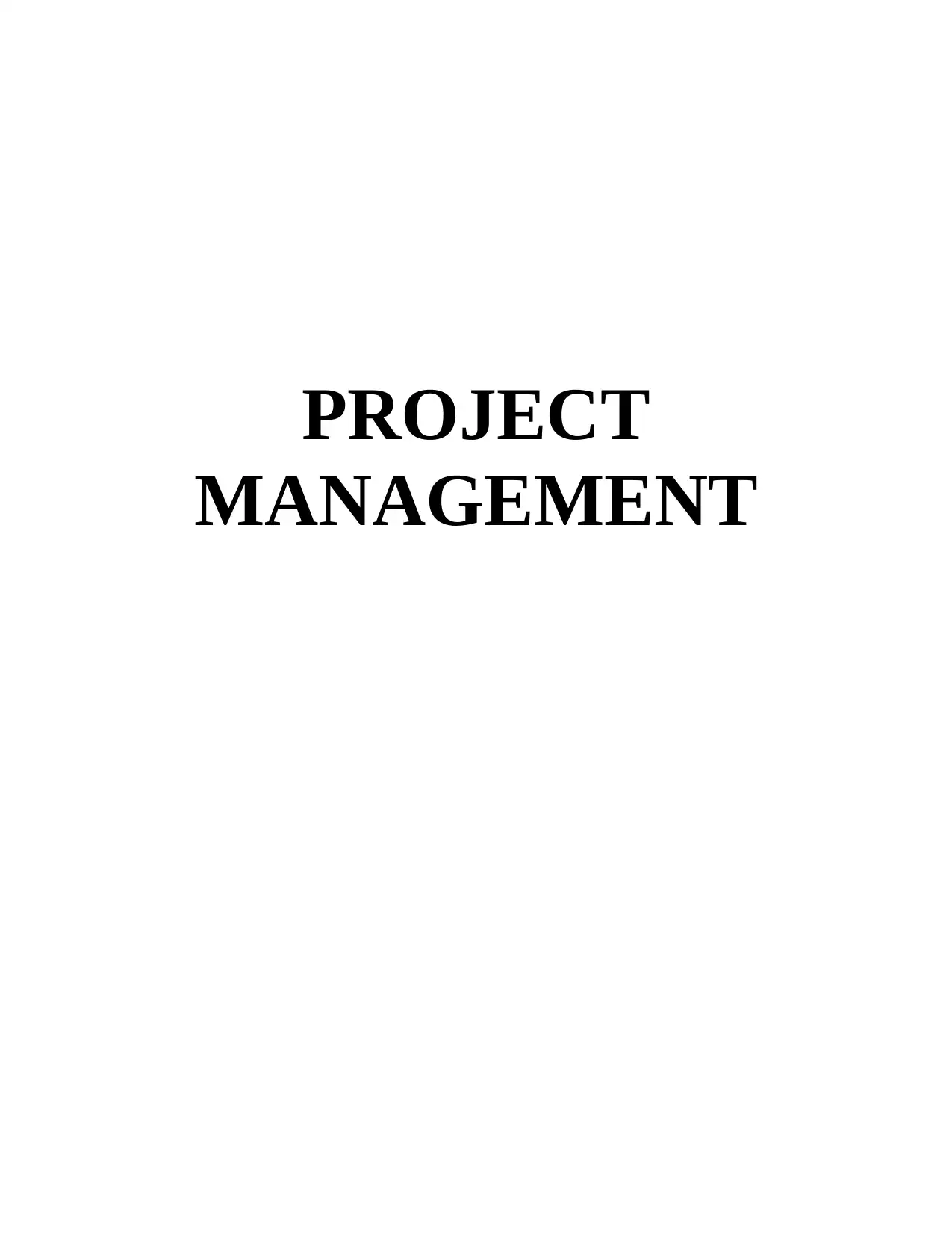
PROJECT
MANAGEMENT
MANAGEMENT
Paraphrase This Document
Need a fresh take? Get an instant paraphrase of this document with our AI Paraphraser
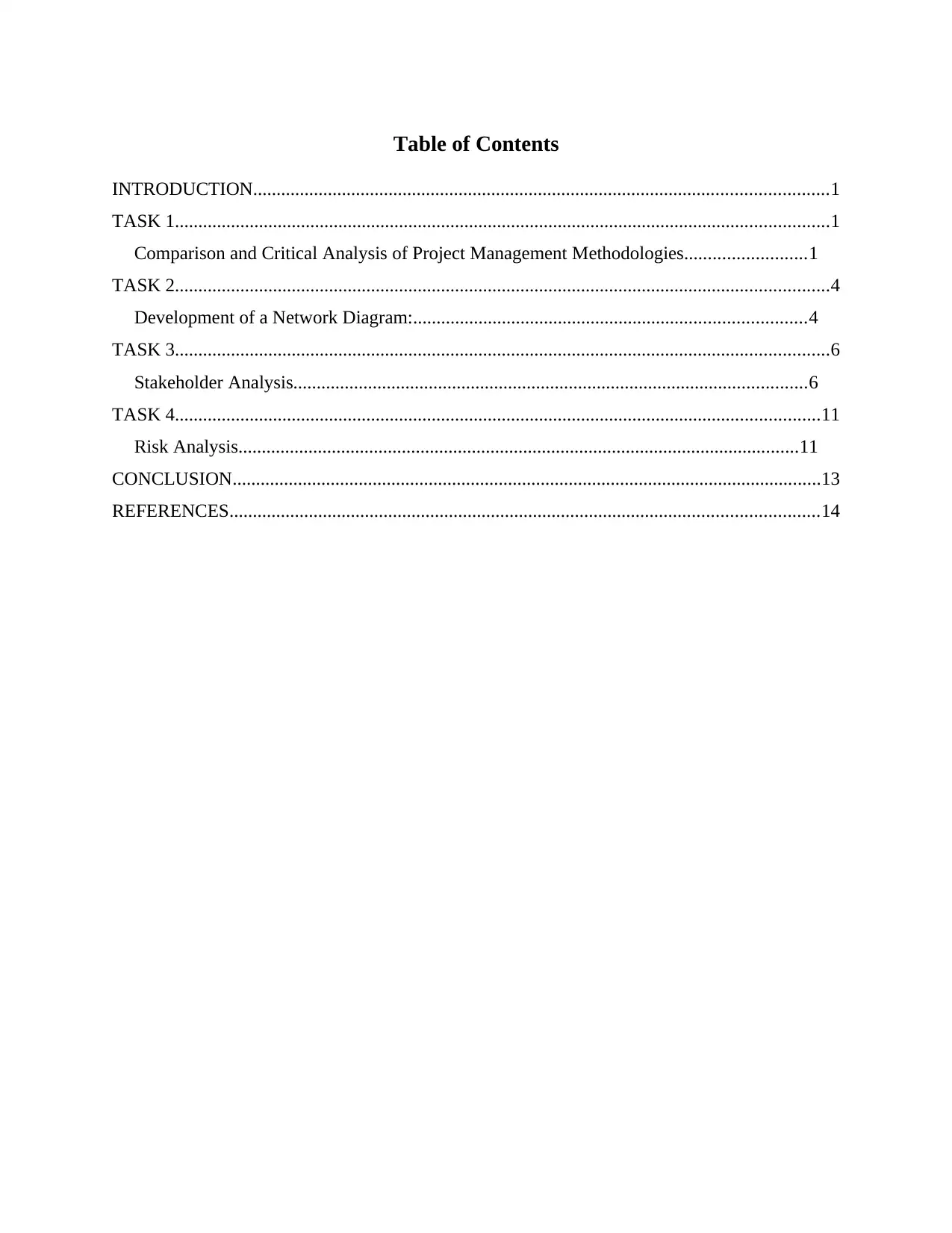
Table of Contents
INTRODUCTION...........................................................................................................................1
TASK 1............................................................................................................................................1
Comparison and Critical Analysis of Project Management Methodologies..........................1
TASK 2............................................................................................................................................4
Development of a Network Diagram:....................................................................................4
TASK 3............................................................................................................................................6
Stakeholder Analysis..............................................................................................................6
TASK 4..........................................................................................................................................11
Risk Analysis........................................................................................................................11
CONCLUSION..............................................................................................................................13
REFERENCES..............................................................................................................................14
INTRODUCTION...........................................................................................................................1
TASK 1............................................................................................................................................1
Comparison and Critical Analysis of Project Management Methodologies..........................1
TASK 2............................................................................................................................................4
Development of a Network Diagram:....................................................................................4
TASK 3............................................................................................................................................6
Stakeholder Analysis..............................................................................................................6
TASK 4..........................................................................................................................................11
Risk Analysis........................................................................................................................11
CONCLUSION..............................................................................................................................13
REFERENCES..............................................................................................................................14
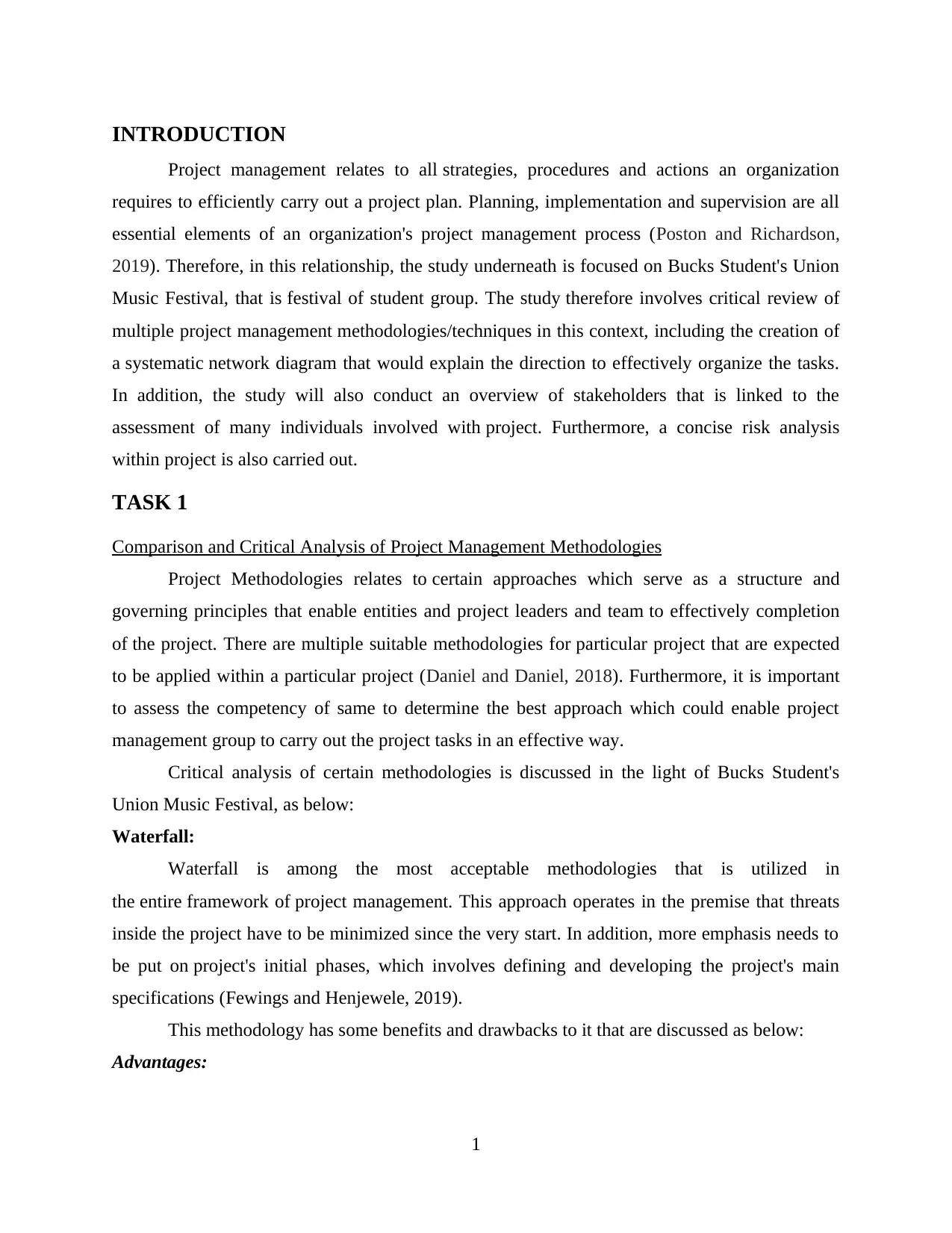
INTRODUCTION
Project management relates to all strategies, procedures and actions an organization
requires to efficiently carry out a project plan. Planning, implementation and supervision are all
essential elements of an organization's project management process (Poston and Richardson,
2019). Therefore, in this relationship, the study underneath is focused on Bucks Student's Union
Music Festival, that is festival of student group. The study therefore involves critical review of
multiple project management methodologies/techniques in this context, including the creation of
a systematic network diagram that would explain the direction to effectively organize the tasks.
In addition, the study will also conduct an overview of stakeholders that is linked to the
assessment of many individuals involved with project. Furthermore, a concise risk analysis
within project is also carried out.
TASK 1
Comparison and Critical Analysis of Project Management Methodologies
Project Methodologies relates to certain approaches which serve as a structure and
governing principles that enable entities and project leaders and team to effectively completion
of the project. There are multiple suitable methodologies for particular project that are expected
to be applied within a particular project (Daniel and Daniel, 2018). Furthermore, it is important
to assess the competency of same to determine the best approach which could enable project
management group to carry out the project tasks in an effective way.
Critical analysis of certain methodologies is discussed in the light of Bucks Student's
Union Music Festival, as below:
Waterfall:
Waterfall is among the most acceptable methodologies that is utilized in
the entire framework of project management. This approach operates in the premise that threats
inside the project have to be minimized since the very start. In addition, more emphasis needs to
be put on project's initial phases, which involves defining and developing the project's main
specifications (Fewings and Henjewele, 2019).
This methodology has some benefits and drawbacks to it that are discussed as below:
Advantages:
1
Project management relates to all strategies, procedures and actions an organization
requires to efficiently carry out a project plan. Planning, implementation and supervision are all
essential elements of an organization's project management process (Poston and Richardson,
2019). Therefore, in this relationship, the study underneath is focused on Bucks Student's Union
Music Festival, that is festival of student group. The study therefore involves critical review of
multiple project management methodologies/techniques in this context, including the creation of
a systematic network diagram that would explain the direction to effectively organize the tasks.
In addition, the study will also conduct an overview of stakeholders that is linked to the
assessment of many individuals involved with project. Furthermore, a concise risk analysis
within project is also carried out.
TASK 1
Comparison and Critical Analysis of Project Management Methodologies
Project Methodologies relates to certain approaches which serve as a structure and
governing principles that enable entities and project leaders and team to effectively completion
of the project. There are multiple suitable methodologies for particular project that are expected
to be applied within a particular project (Daniel and Daniel, 2018). Furthermore, it is important
to assess the competency of same to determine the best approach which could enable project
management group to carry out the project tasks in an effective way.
Critical analysis of certain methodologies is discussed in the light of Bucks Student's
Union Music Festival, as below:
Waterfall:
Waterfall is among the most acceptable methodologies that is utilized in
the entire framework of project management. This approach operates in the premise that threats
inside the project have to be minimized since the very start. In addition, more emphasis needs to
be put on project's initial phases, which involves defining and developing the project's main
specifications (Fewings and Henjewele, 2019).
This methodology has some benefits and drawbacks to it that are discussed as below:
Advantages:
1
⊘ This is a preview!⊘
Do you want full access?
Subscribe today to unlock all pages.

Trusted by 1+ million students worldwide
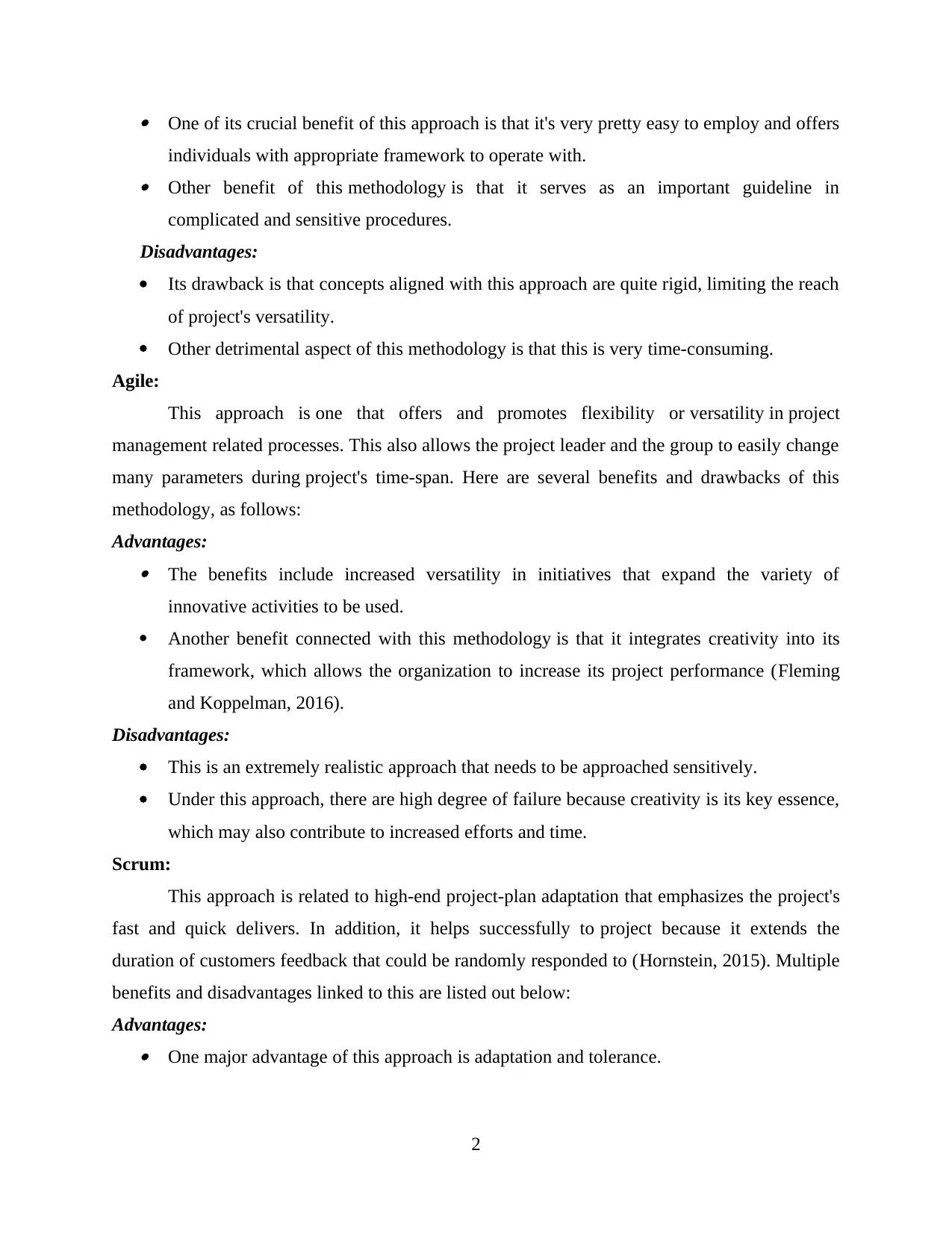
One of its crucial benefit of this approach is that it's very pretty easy to employ and offers
individuals with appropriate framework to operate with. Other benefit of this methodology is that it serves as an important guideline in
complicated and sensitive procedures.
Disadvantages:
Its drawback is that concepts aligned with this approach are quite rigid, limiting the reach
of project's versatility.
Other detrimental aspect of this methodology is that this is very time-consuming.
Agile:
This approach is one that offers and promotes flexibility or versatility in project
management related processes. This also allows the project leader and the group to easily change
many parameters during project's time-span. Here are several benefits and drawbacks of this
methodology, as follows:
Advantages: The benefits include increased versatility in initiatives that expand the variety of
innovative activities to be used.
Another benefit connected with this methodology is that it integrates creativity into its
framework, which allows the organization to increase its project performance (Fleming
and Koppelman, 2016).
Disadvantages:
This is an extremely realistic approach that needs to be approached sensitively.
Under this approach, there are high degree of failure because creativity is its key essence,
which may also contribute to increased efforts and time.
Scrum:
This approach is related to high-end project-plan adaptation that emphasizes the project's
fast and quick delivers. In addition, it helps successfully to project because it extends the
duration of customers feedback that could be randomly responded to (Hornstein, 2015). Multiple
benefits and disadvantages linked to this are listed out below:
Advantages: One major advantage of this approach is adaptation and tolerance.
2
individuals with appropriate framework to operate with. Other benefit of this methodology is that it serves as an important guideline in
complicated and sensitive procedures.
Disadvantages:
Its drawback is that concepts aligned with this approach are quite rigid, limiting the reach
of project's versatility.
Other detrimental aspect of this methodology is that this is very time-consuming.
Agile:
This approach is one that offers and promotes flexibility or versatility in project
management related processes. This also allows the project leader and the group to easily change
many parameters during project's time-span. Here are several benefits and drawbacks of this
methodology, as follows:
Advantages: The benefits include increased versatility in initiatives that expand the variety of
innovative activities to be used.
Another benefit connected with this methodology is that it integrates creativity into its
framework, which allows the organization to increase its project performance (Fleming
and Koppelman, 2016).
Disadvantages:
This is an extremely realistic approach that needs to be approached sensitively.
Under this approach, there are high degree of failure because creativity is its key essence,
which may also contribute to increased efforts and time.
Scrum:
This approach is related to high-end project-plan adaptation that emphasizes the project's
fast and quick delivers. In addition, it helps successfully to project because it extends the
duration of customers feedback that could be randomly responded to (Hornstein, 2015). Multiple
benefits and disadvantages linked to this are listed out below:
Advantages: One major advantage of this approach is adaptation and tolerance.
2
Paraphrase This Document
Need a fresh take? Get an instant paraphrase of this document with our AI Paraphraser
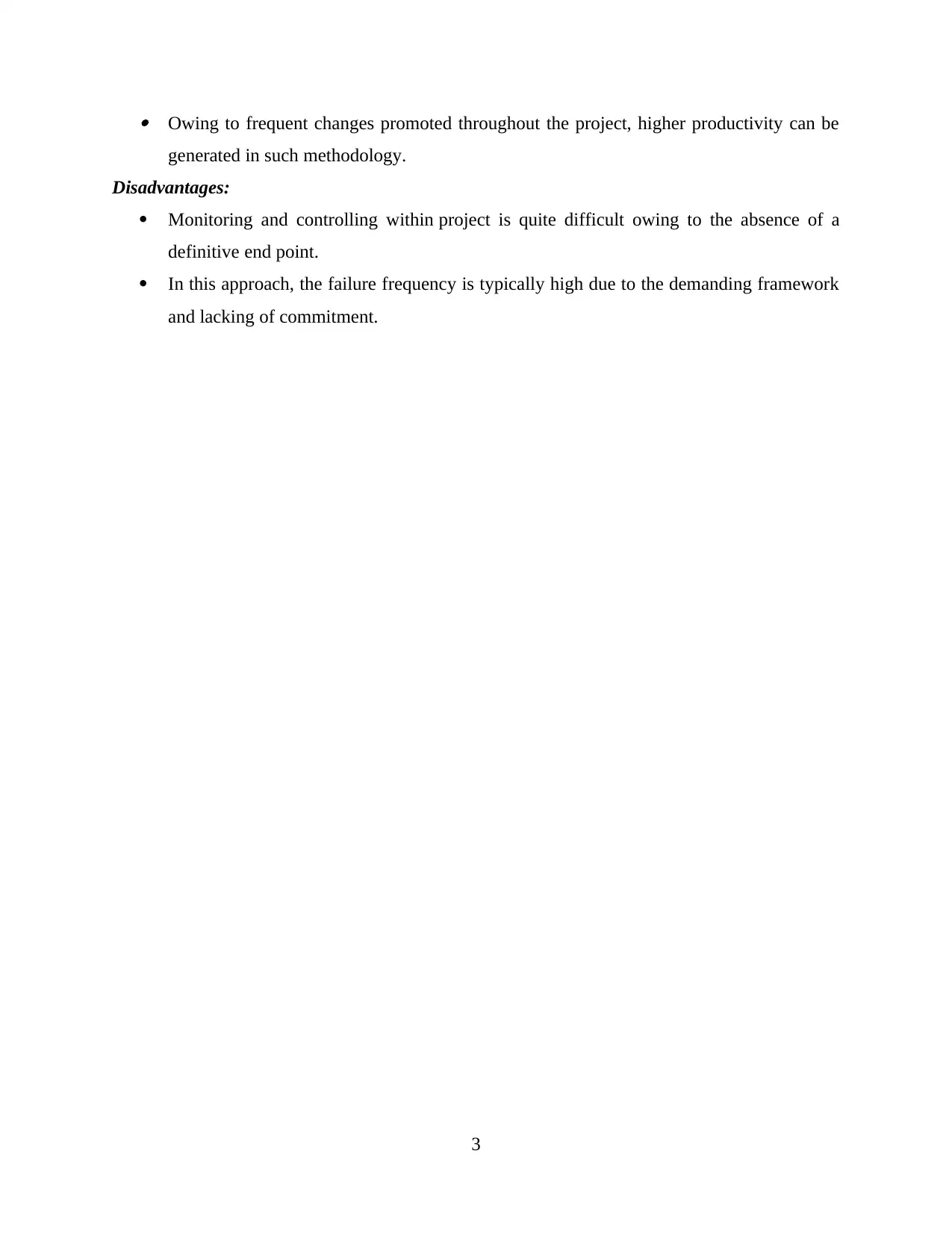
Owing to frequent changes promoted throughout the project, higher productivity can be
generated in such methodology.
Disadvantages:
Monitoring and controlling within project is quite difficult owing to the absence of a
definitive end point.
In this approach, the failure frequency is typically high due to the demanding framework
and lacking of commitment.
3
generated in such methodology.
Disadvantages:
Monitoring and controlling within project is quite difficult owing to the absence of a
definitive end point.
In this approach, the failure frequency is typically high due to the demanding framework
and lacking of commitment.
3
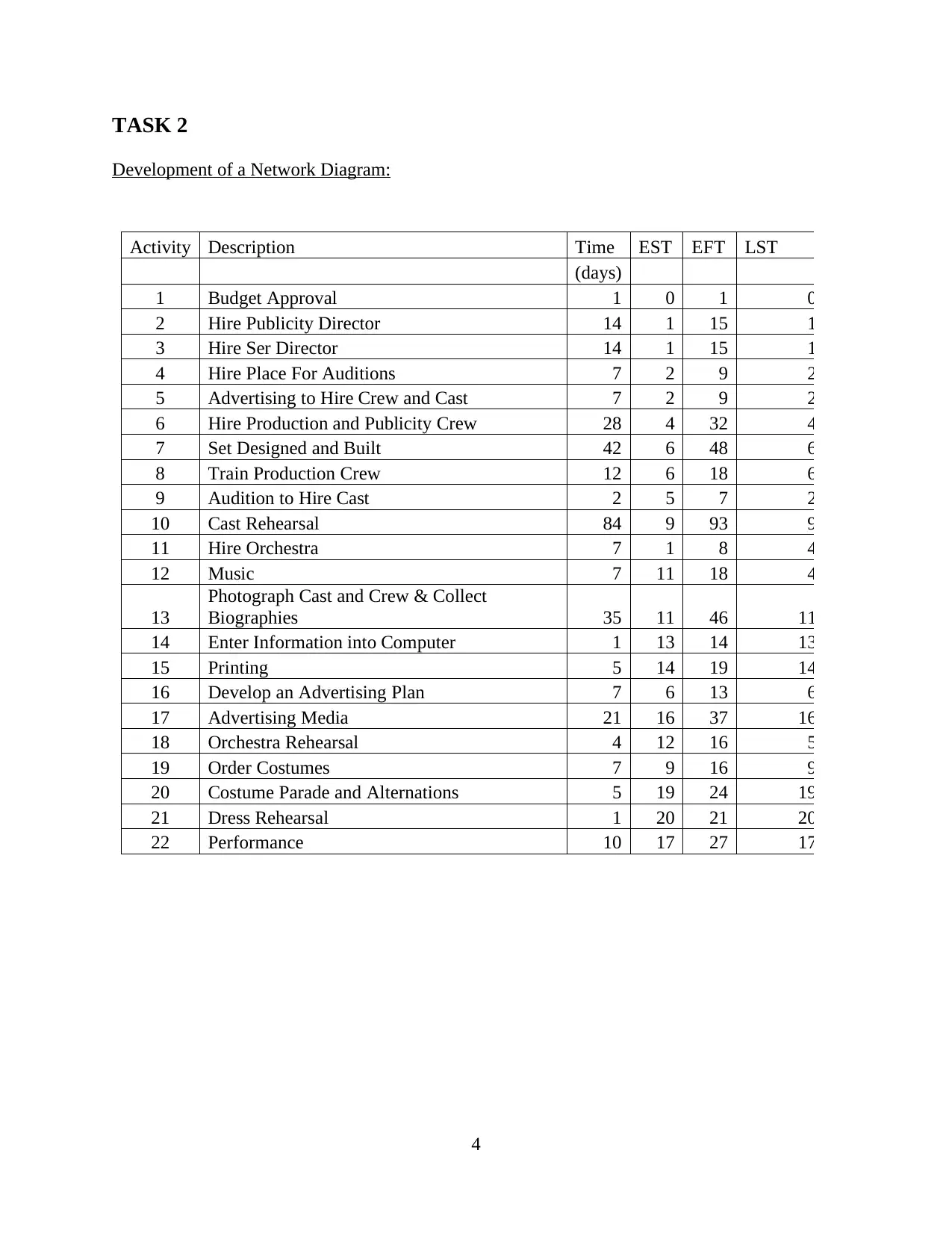
TASK 2
Development of a Network Diagram:
Activity Description Time EST EFT LST
(days)
1 Budget Approval 1 0 1 0
2 Hire Publicity Director 14 1 15 1
3 Hire Ser Director 14 1 15 1
4 Hire Place For Auditions 7 2 9 2
5 Advertising to Hire Crew and Cast 7 2 9 2
6 Hire Production and Publicity Crew 28 4 32 4
7 Set Designed and Built 42 6 48 6
8 Train Production Crew 12 6 18 6
9 Audition to Hire Cast 2 5 7 2
10 Cast Rehearsal 84 9 93 9
11 Hire Orchestra 7 1 8 4
12 Music 7 11 18 4
13
Photograph Cast and Crew & Collect
Biographies 35 11 46 11
14 Enter Information into Computer 1 13 14 13
15 Printing 5 14 19 14
16 Develop an Advertising Plan 7 6 13 6
17 Advertising Media 21 16 37 16
18 Orchestra Rehearsal 4 12 16 5
19 Order Costumes 7 9 16 9
20 Costume Parade and Alternations 5 19 24 19
21 Dress Rehearsal 1 20 21 20
22 Performance 10 17 27 17
4
Development of a Network Diagram:
Activity Description Time EST EFT LST
(days)
1 Budget Approval 1 0 1 0
2 Hire Publicity Director 14 1 15 1
3 Hire Ser Director 14 1 15 1
4 Hire Place For Auditions 7 2 9 2
5 Advertising to Hire Crew and Cast 7 2 9 2
6 Hire Production and Publicity Crew 28 4 32 4
7 Set Designed and Built 42 6 48 6
8 Train Production Crew 12 6 18 6
9 Audition to Hire Cast 2 5 7 2
10 Cast Rehearsal 84 9 93 9
11 Hire Orchestra 7 1 8 4
12 Music 7 11 18 4
13
Photograph Cast and Crew & Collect
Biographies 35 11 46 11
14 Enter Information into Computer 1 13 14 13
15 Printing 5 14 19 14
16 Develop an Advertising Plan 7 6 13 6
17 Advertising Media 21 16 37 16
18 Orchestra Rehearsal 4 12 16 5
19 Order Costumes 7 9 16 9
20 Costume Parade and Alternations 5 19 24 19
21 Dress Rehearsal 1 20 21 20
22 Performance 10 17 27 17
4
⊘ This is a preview!⊘
Do you want full access?
Subscribe today to unlock all pages.

Trusted by 1+ million students worldwide
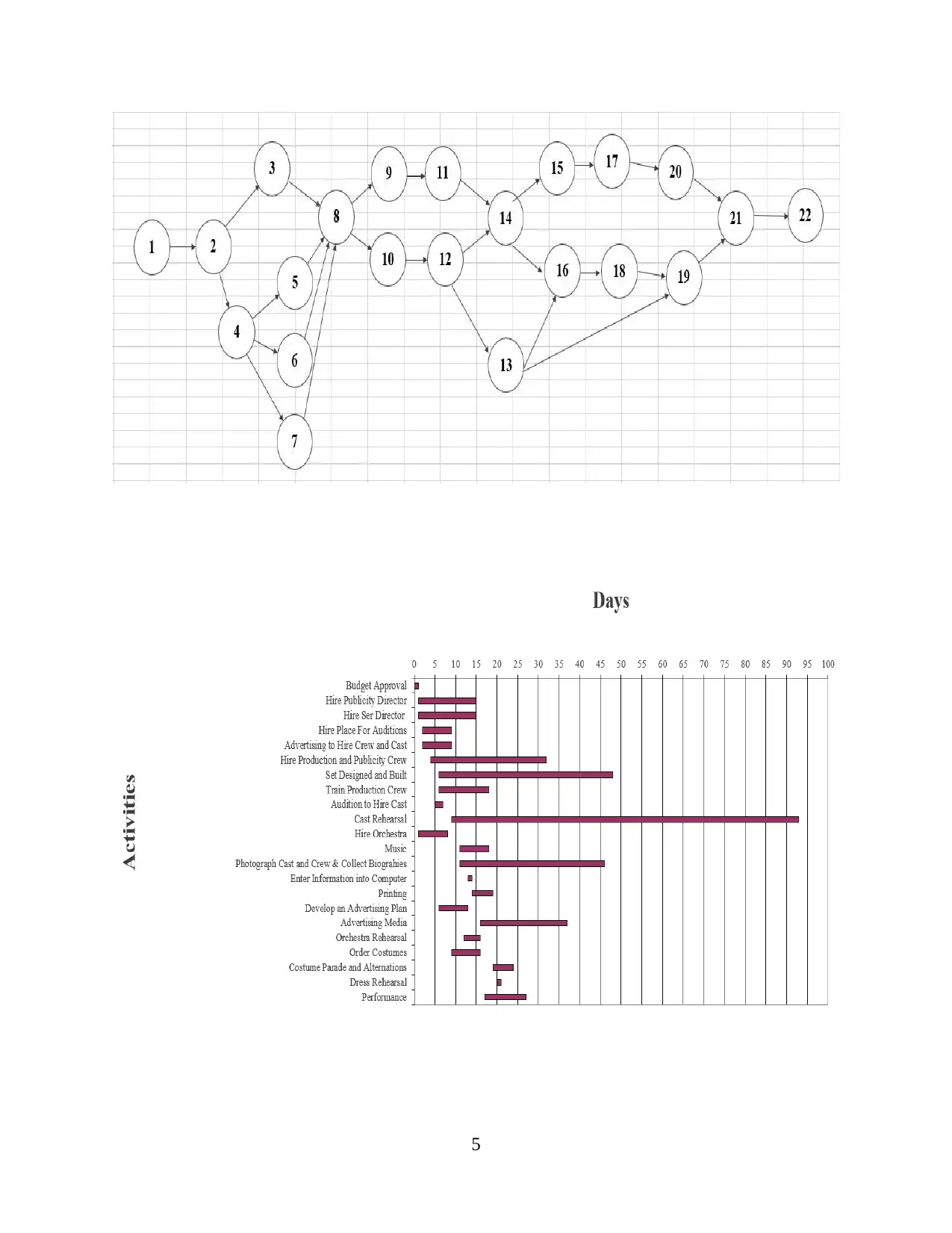
5
Paraphrase This Document
Need a fresh take? Get an instant paraphrase of this document with our AI Paraphraser
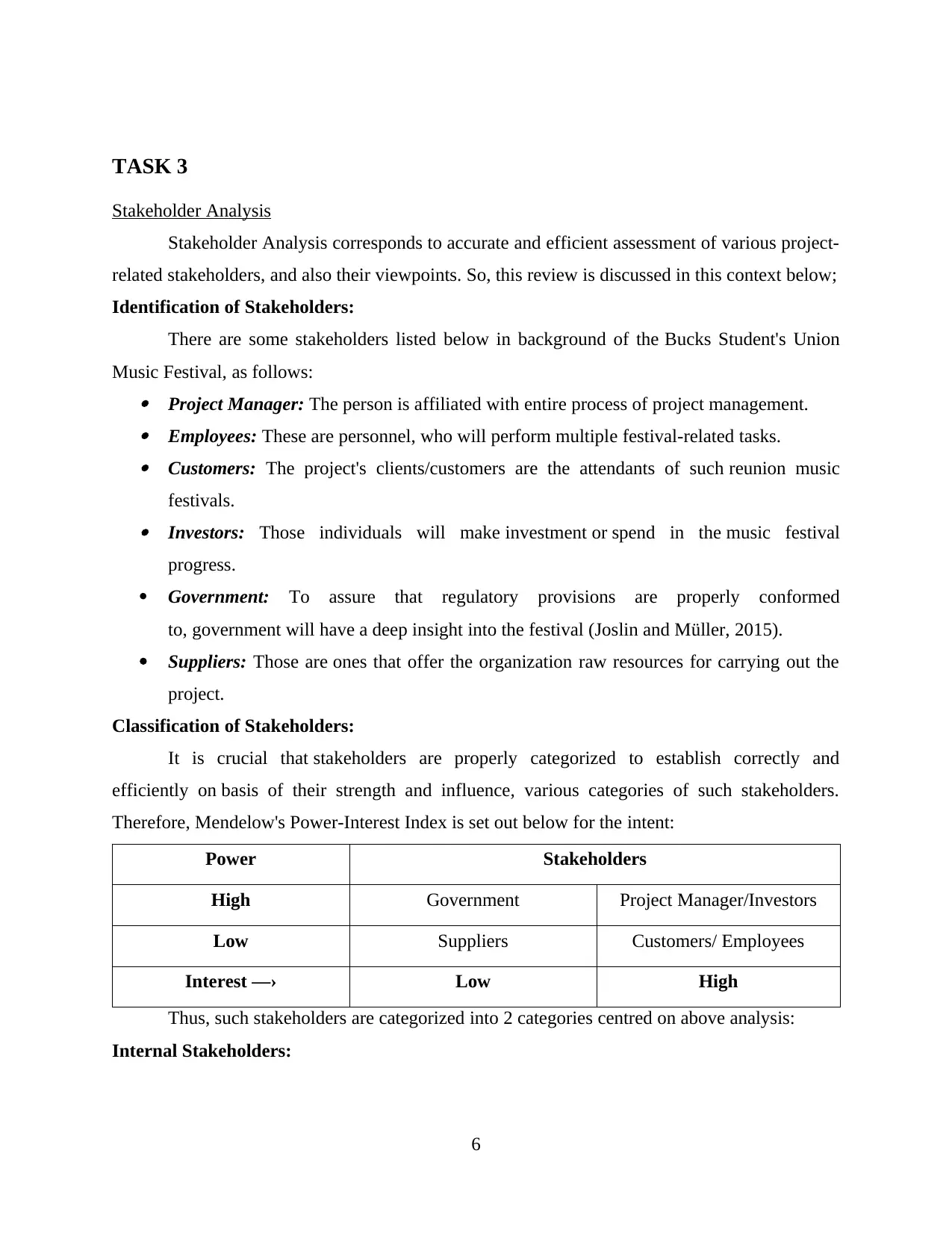
TASK 3
Stakeholder Analysis
Stakeholder Analysis corresponds to accurate and efficient assessment of various project-
related stakeholders, and also their viewpoints. So, this review is discussed in this context below;
Identification of Stakeholders:
There are some stakeholders listed below in background of the Bucks Student's Union
Music Festival, as follows: Project Manager: The person is affiliated with entire process of project management. Employees: These are personnel, who will perform multiple festival-related tasks. Customers: The project's clients/customers are the attendants of such reunion music
festivals. Investors: Those individuals will make investment or spend in the music festival
progress.
Government: To assure that regulatory provisions are properly conformed
to, government will have a deep insight into the festival (Joslin and Müller, 2015).
Suppliers: Those are ones that offer the organization raw resources for carrying out the
project.
Classification of Stakeholders:
It is crucial that stakeholders are properly categorized to establish correctly and
efficiently on basis of their strength and influence, various categories of such stakeholders.
Therefore, Mendelow's Power-Interest Index is set out below for the intent:
Power Stakeholders
High Government Project Manager/Investors
Low Suppliers Customers/ Employees
Interest ―› Low High
Thus, such stakeholders are categorized into 2 categories centred on above analysis:
Internal Stakeholders:
6
Stakeholder Analysis
Stakeholder Analysis corresponds to accurate and efficient assessment of various project-
related stakeholders, and also their viewpoints. So, this review is discussed in this context below;
Identification of Stakeholders:
There are some stakeholders listed below in background of the Bucks Student's Union
Music Festival, as follows: Project Manager: The person is affiliated with entire process of project management. Employees: These are personnel, who will perform multiple festival-related tasks. Customers: The project's clients/customers are the attendants of such reunion music
festivals. Investors: Those individuals will make investment or spend in the music festival
progress.
Government: To assure that regulatory provisions are properly conformed
to, government will have a deep insight into the festival (Joslin and Müller, 2015).
Suppliers: Those are ones that offer the organization raw resources for carrying out the
project.
Classification of Stakeholders:
It is crucial that stakeholders are properly categorized to establish correctly and
efficiently on basis of their strength and influence, various categories of such stakeholders.
Therefore, Mendelow's Power-Interest Index is set out below for the intent:
Power Stakeholders
High Government Project Manager/Investors
Low Suppliers Customers/ Employees
Interest ―› Low High
Thus, such stakeholders are categorized into 2 categories centred on above analysis:
Internal Stakeholders:
6
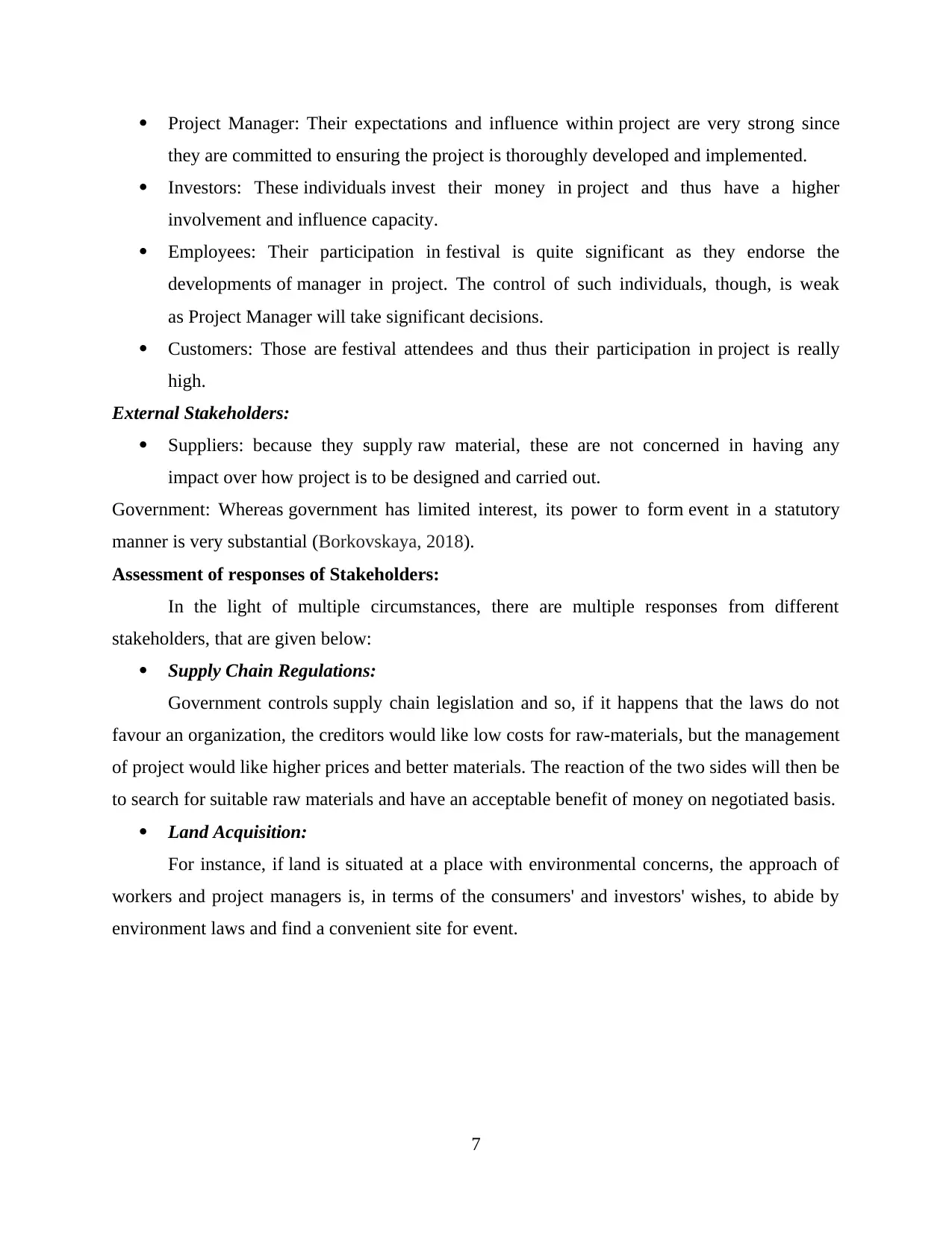
Project Manager: Their expectations and influence within project are very strong since
they are committed to ensuring the project is thoroughly developed and implemented.
Investors: These individuals invest their money in project and thus have a higher
involvement and influence capacity.
Employees: Their participation in festival is quite significant as they endorse the
developments of manager in project. The control of such individuals, though, is weak
as Project Manager will take significant decisions.
Customers: Those are festival attendees and thus their participation in project is really
high.
External Stakeholders:
Suppliers: because they supply raw material, these are not concerned in having any
impact over how project is to be designed and carried out.
Government: Whereas government has limited interest, its power to form event in a statutory
manner is very substantial (Borkovskaya, 2018).
Assessment of responses of Stakeholders:
In the light of multiple circumstances, there are multiple responses from different
stakeholders, that are given below:
Supply Chain Regulations:
Government controls supply chain legislation and so, if it happens that the laws do not
favour an organization, the creditors would like low costs for raw-materials, but the management
of project would like higher prices and better materials. The reaction of the two sides will then be
to search for suitable raw materials and have an acceptable benefit of money on negotiated basis.
Land Acquisition:
For instance, if land is situated at a place with environmental concerns, the approach of
workers and project managers is, in terms of the consumers' and investors' wishes, to abide by
environment laws and find a convenient site for event.
7
they are committed to ensuring the project is thoroughly developed and implemented.
Investors: These individuals invest their money in project and thus have a higher
involvement and influence capacity.
Employees: Their participation in festival is quite significant as they endorse the
developments of manager in project. The control of such individuals, though, is weak
as Project Manager will take significant decisions.
Customers: Those are festival attendees and thus their participation in project is really
high.
External Stakeholders:
Suppliers: because they supply raw material, these are not concerned in having any
impact over how project is to be designed and carried out.
Government: Whereas government has limited interest, its power to form event in a statutory
manner is very substantial (Borkovskaya, 2018).
Assessment of responses of Stakeholders:
In the light of multiple circumstances, there are multiple responses from different
stakeholders, that are given below:
Supply Chain Regulations:
Government controls supply chain legislation and so, if it happens that the laws do not
favour an organization, the creditors would like low costs for raw-materials, but the management
of project would like higher prices and better materials. The reaction of the two sides will then be
to search for suitable raw materials and have an acceptable benefit of money on negotiated basis.
Land Acquisition:
For instance, if land is situated at a place with environmental concerns, the approach of
workers and project managers is, in terms of the consumers' and investors' wishes, to abide by
environment laws and find a convenient site for event.
7
⊘ This is a preview!⊘
Do you want full access?
Subscribe today to unlock all pages.

Trusted by 1+ million students worldwide
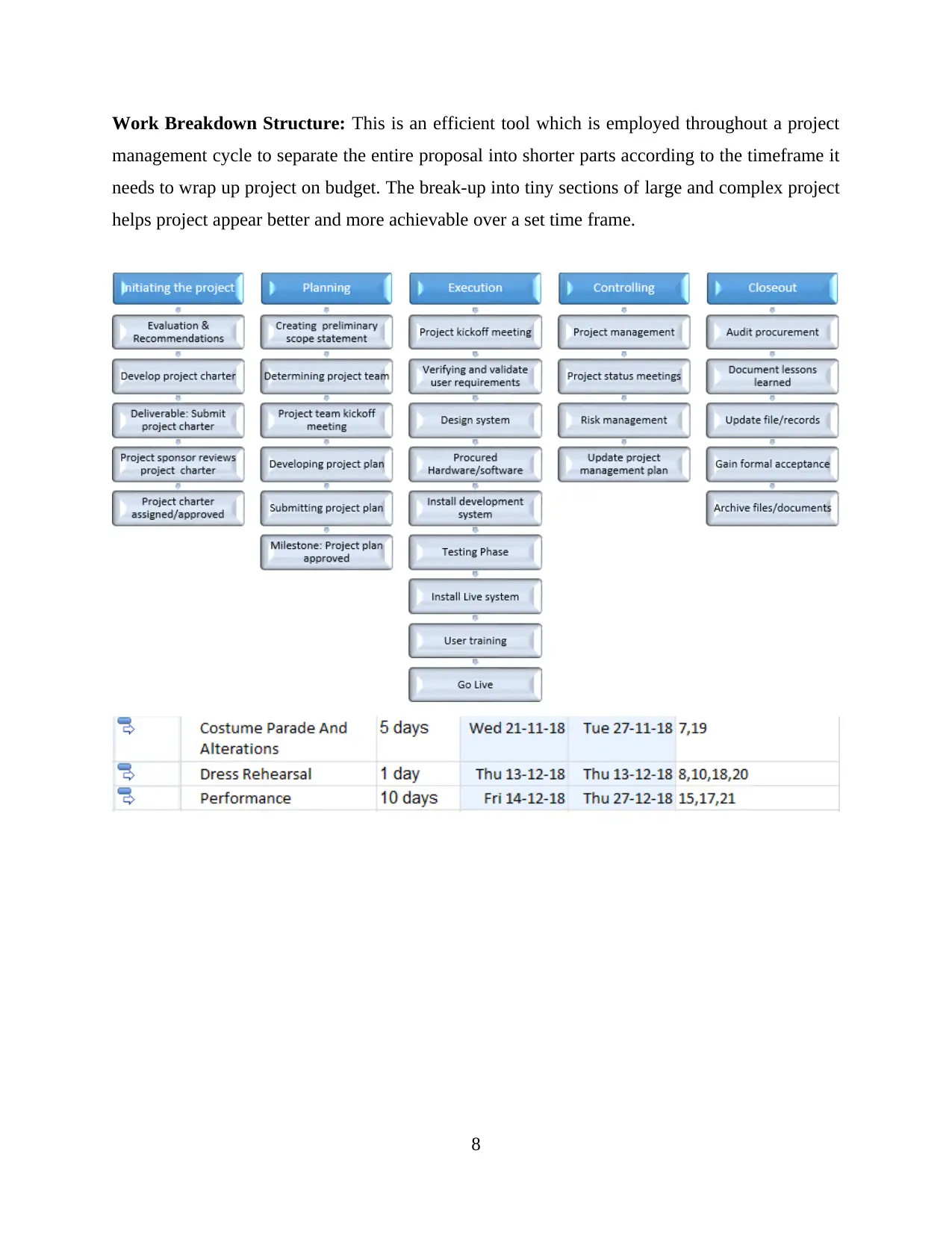
Work Breakdown Structure: This is an efficient tool which is employed throughout a project
management cycle to separate the entire proposal into shorter parts according to the timeframe it
needs to wrap up project on budget. The break-up into tiny sections of large and complex project
helps project appear better and more achievable over a set time frame.
8
management cycle to separate the entire proposal into shorter parts according to the timeframe it
needs to wrap up project on budget. The break-up into tiny sections of large and complex project
helps project appear better and more achievable over a set time frame.
8
Paraphrase This Document
Need a fresh take? Get an instant paraphrase of this document with our AI Paraphraser
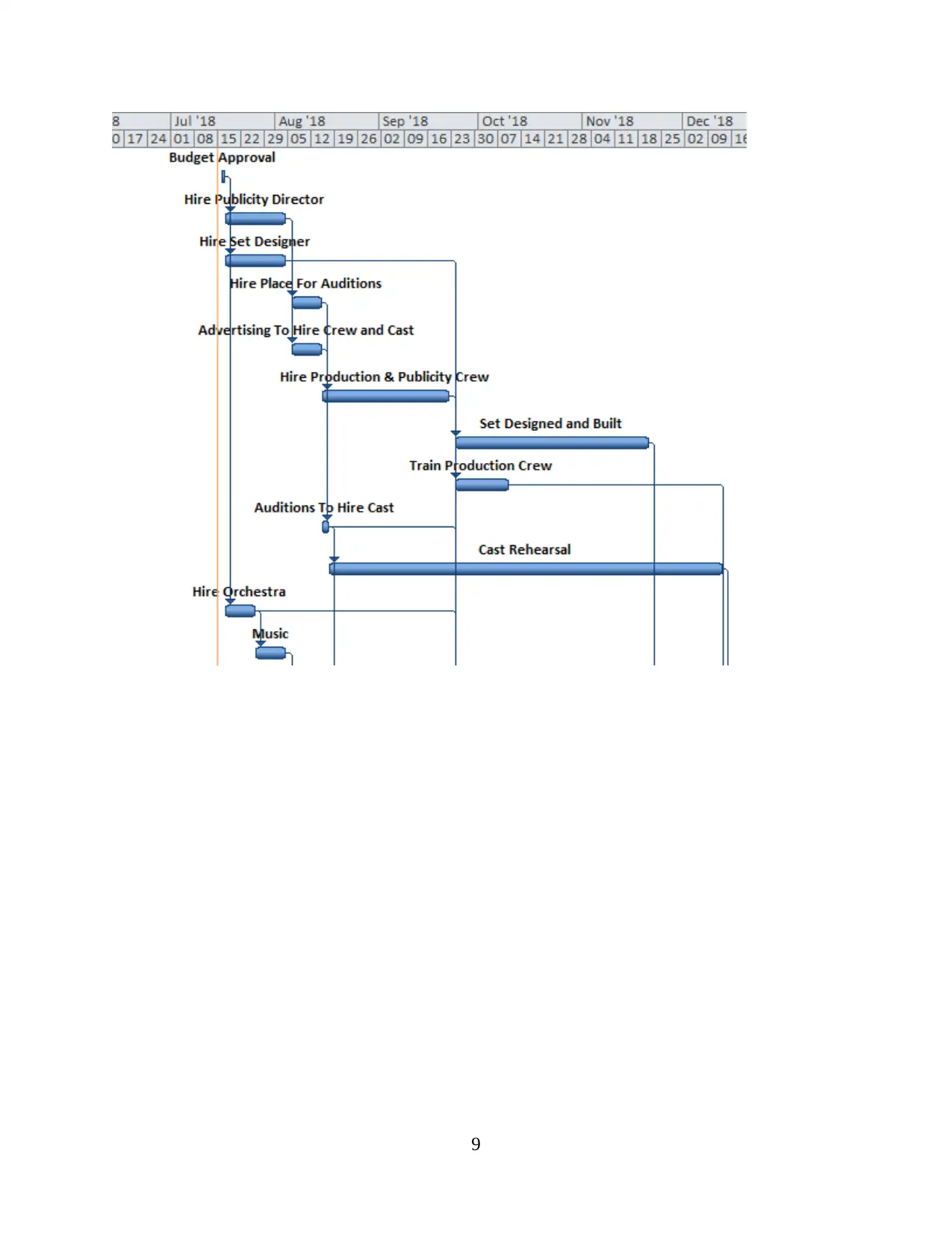
9
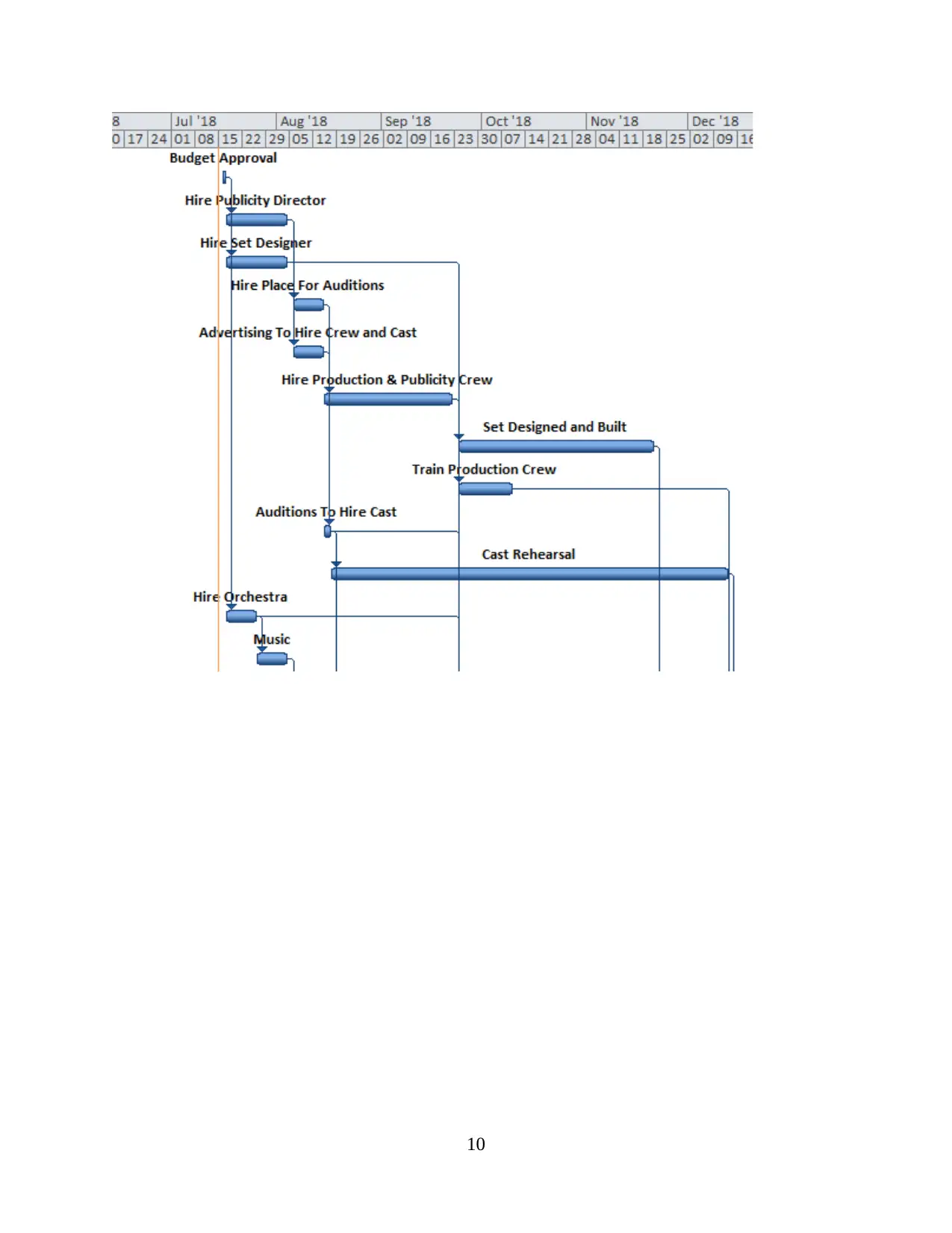
10
⊘ This is a preview!⊘
Do you want full access?
Subscribe today to unlock all pages.

Trusted by 1+ million students worldwide
1 out of 16
Related Documents
Your All-in-One AI-Powered Toolkit for Academic Success.
+13062052269
info@desklib.com
Available 24*7 on WhatsApp / Email
![[object Object]](/_next/static/media/star-bottom.7253800d.svg)
Unlock your academic potential
Copyright © 2020–2025 A2Z Services. All Rights Reserved. Developed and managed by ZUCOL.




